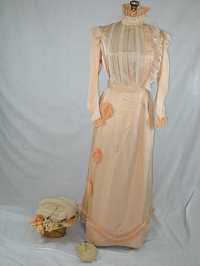1897
This afternoon suit is a peaches and cream confection of taffeta, organza and lace. The term suit applied to a set of garments intended to be worn together and the word was commonly used for what we call dresses today. The skirt now fits tightly to the hips, flows gently to the floor, and is decorated around the bottom. Favored materials were silk warp wool challis, cashmeres and taffetas. Transparent fabrics were used for the blossoms, ruffles, and rosettes which trailed across the skirts and up the bodice. In 1897 fashion went into a transition. The emphasis on the shoulder was reduced to a kind of epaulette over slim sleeves with some gathers at the top. Edgings were seen at the wrists. Fullness moved to the bodice and there developed a "chest out" look. This bosom enlarged further, early in the 20th century. This new fashion cycle featured the reverse-S silhouette. Bodices had high necks which were stiffened with boning to keep the head back and the chin out. Exaggerated fullness was added to the bodice front. A proper corset was essential to the fit of any period from girlhood to death, most women went about their daily activities encased in such a brace. Even the rural poor, donned them as a holiday luxury.
Materials were still firm except for the trimming. Wools such as alpaca, of which the original gown was constructed, as well as taffetas like this were popular. Much decorated bodices were firmly attached or mounted on tightly fitted, front hooked linings, then the outer part was closed by several hooks on the left side. To give a look of continuous neck band, the high collar hooks in the back. Epaulettes and shoulder frills emphasize a continued interest in the sleeve area. The waist was smaller in the 1890s than any other time in history. Corsets donned at least one hour before were pulled tighter when dressing. Slightly gored skirts had all the fullness gathered center back and there is a pocket in the opening for necessities. Artificial pads were no longer worn except where nature was deficient. Indoor caps were discarded in the 1870s except for night wear and by the 1890s the central heating made even them unnecessary. This is one of the newest outfits in the show and does not have the accessories. A well-dressed woman would need to be fashionable in the Gay 90s, such as her hat, a chatelain purse and silk undies.
Toward the end of the 1880s skirts had widened again and the close fitting sleeve began to balloon at the top until by 1895 the leg-o-mutton sleeve was in full sail. But the affluence of the times could not only be seen in the increased amount of clothing a woman owned but in the faster new styles were adopted and then discarded. In 1898 the sleeve had returned to a sensible shape.
Parasol of antique satin has cotton lace applied between the panels and along the edge. A puff of silk. Hat of straw, flowers, feathers, and tulle top the upswept hair styles. Gloves and a purse complete the illusion.
Click photo for detailed views.


